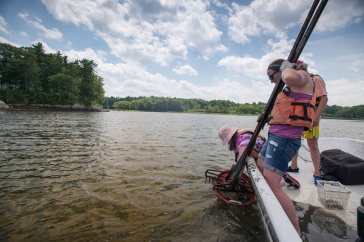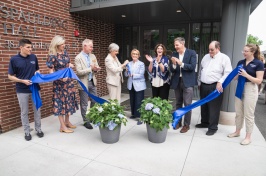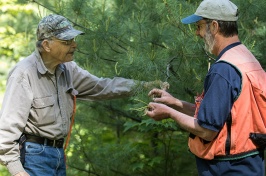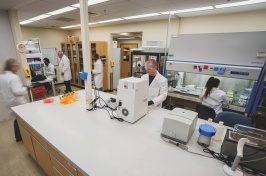The University of New Hampshire is a flagship research university that inspires innovation and transforms lives in our state, nation and world. More than 16,000 students from all 50 states and 71 countries engage with an award-winning faculty in top ranked programs in business, engineering, law, health and human services, liberal arts and the sciences across more than 200 programs of study. UNH’s research portfolio includes partnerships with NASA, NOAA, NSF and NIH, receiving more than $100 million in competitive external funding every year to further explore and define the frontiers of land, sea and space.
UNH Researchers ID New Bacterial Pathogen Contaminating Seafood

In the Great Bay Estuary, a team of undergraduate and graduate students collect oysters to look at environmental conditions that might favor Vibrio parahaemolyticus. Credit: UNH
DURHAM, N.H. – University of New Hampshire scientists, in partnership with the FDA and public health and shellfish management agencies in five states, have identified a new strain of a bacterial pathogen that has contaminated seafood, sickening shellfish consumers along the Atlantic Coast of North America at increasing rates over the last decade.
“We identified this strain nearly 10 years ago in New Hampshire where there have been no reported shellfish-borne infections, and more than five years ago from clinical sources from Massachusetts so we knew it was a potential problem. We were surprised to learn that it was so widespread and that it could thrive in such contrasting water temperatures as would be found in Florida compared to Prince Edward Island and the Gulf of Maine,” said Cheryl Whistler, associate professor of molecular, cellular, and biomedical sciences and director of the Northeast Center for Vibrio Disease and Ecology at UNH.
This Vibrio parahaemolyticus strain, identified as ST631, is the predominant strain endemic to the Atlantic Coast of North America and has been traced to shellfish harvested in seven Atlantic coastal states and Canada. It is the second most prevalent strain isolated from patients sickened by product sourced to the Northeast United States. Vibrio parahaemolyticus is the leading seafood-transmitted bacterial pathogen worldwide with an estimated 45,000 infections in the United States every year. It causes gastroenteritis and, rarely, lethal blood poisoning. The findings were announced in a letter to the editor in the Journal of Clinical Microbiology.
UNH researchers and their collaborators now will develop quantitative methods for detecting this strain in the environment, and conduct additional analysis to understand how this pathogen evolved from harmless to pathogenic. “We now know which strain is out there in shellfish areas, which means with directed surveillance, we can monitor its presence, its spread, and importantly reduce infections,” Whistler said.
In addition to Whistler, UNH researchers involved with this study include Steve Jones, research associate professor of natural resources and associate director of NH Sea Grant, and Feng Xu, a genetics doctoral student and researcher with the Northeast Center for Vibrio Disease and Ecology. Researchers partnered with scientists with the Center for Food Safety and Applied Nutrition, Food and Drug Administration; Department of Health and Mental Hygiene, Baltimore, Maryland; Massachusetts Department of Public Health; Massachusetts Division of Marine Fisheries; Department of Public Health Laboratory, Rocky Hill, Conn.; Department of Agriculture, Bureau of Aquaculture, State of Connecticut; Department of Health and Human Services, Augusta, Maine; Icahn Institute and Department of Genetics & Genomic Sciences, Icahn School of Medicine at Mount Sinai; and Microbiology and Molecular Genetics, University of Pittsburgh School of Medicine.
This material is based upon work supported by the NH Agricultural Experiment Station, through joint funding of the National Institute of Food and Agriculture, U.S. Department of Agriculture, under award numbers 233555 and 1004199, and the state of New Hampshire. This work also is supported by funding from the National Science Foundation EPSCoR Program, New Hampshire Sea Grant College Program, National Institutes of Health, and the UNH Graduate School.
Founded in 1887, the NH Agricultural Experiment Station at the UNH College of Life Sciences and Agriculture is UNH’s original research center and an elemental component of New Hampshire's land-grant university heritage and mission.
EDITORS AND REPORTERS: Cheryl Whistler, associate professor of molecular, cellular, and biomedical sciences and director of the Northeast Center for Vibrio Disease and Ecology at UNH, can be reached at cheryl.whistler@unh.edu.
-
Media Contact
Lori Tyler Gula, PhD | NH Agricultural Experiment Station | lori.gula@unh.edu | 603-862-1452
Latest News
-
June 25, 2025
-
June 16, 2025
-
June 6, 2025
-
May 15, 2025
-
May 14, 2025
















































